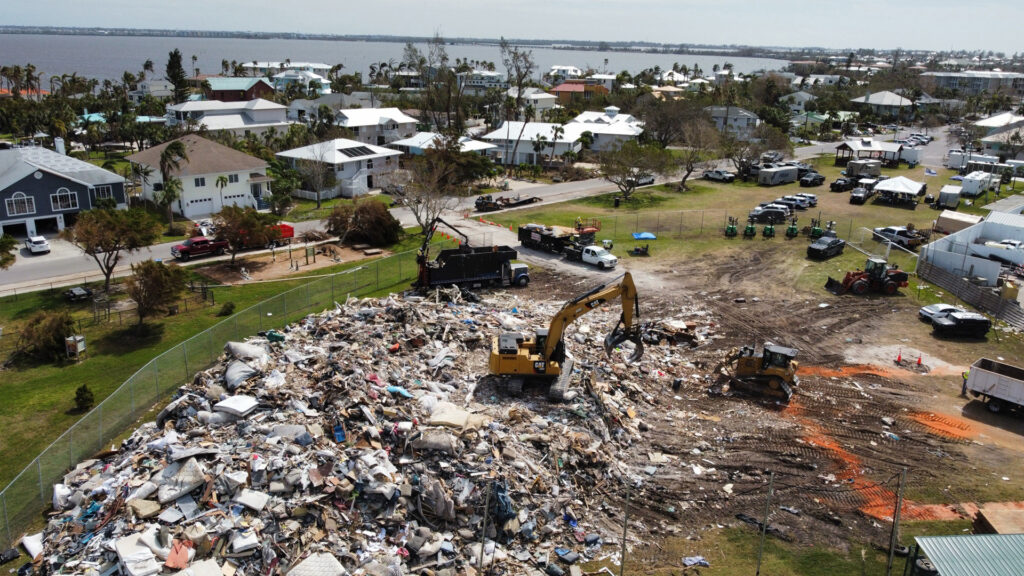By Mia McCormick, Environment Florida
When we think of Florida, beaches with turquoise water and cool crystal-clear springs come to mind. Scenes of playful dolphins, seaweed munching manatees and shiny flashes of fish are common here, yet still somehow unforgettable. But last fall, those animals and the people who came to play in our waters experienced a very different scene.
After hurricanes Helene and Milton, hundreds of pollution reports poured into the Florida Department of Environment Protection (DEP). These storms produced some of the strongest rain and tidal surge events the Gulf coast of Florida had ever seen. Hurricane Milton spanned the state, dumping 19 inches of rain in St. Petersburg and 10 inches over in Vero Beach.
Sanitation systems were overwhelmed by the deluge, dumping more than 70 million gallons of pollutants into our waterways, neighborhoods and communities, according to an analysis from the Environment Florida Research & Policy Center. That’s enough to fill 106 Olympic-sized swimming pools. Just two weeks earlier, another 21 million gallons of pollution was reported from severe rain and Hurricane Helene.
Sewage ruins everything

The majority of the pollution reported to DEP during last year’s hurricanes was sewage. That’s untreated human waste that pushed up through toilets and bathtubs, bubbled out of manholes and overflowed from lift stations and water treatment plants.
“The flood water was expected, but I didn’t expect the sewage. I threw out all of my 9 year old’s toys and clothes; there was feces floating in our bedroom,” said Oldsmar resident Gloria Arnett.
Nearby neighbor Alexis Anthony said brownish-yellow stinky water flowed in through her front door. “You want to cry, you don’t know what to do. There was no saving anything that was below 4 feet in the house.”
When sewage enters our waters, they become unhealthy for swimming. Across Florida, 70% of beaches tested had potentially unsafe levels of fecal contamination on at least one day in 2022, according to an Environment Florida Research & Policy Center Safe for Swimming report.
Scientists estimate 57 million instances of people getting sick each year in the United States from swimming in polluted waters. Those illnesses can include nausea, diarrhea, ear infections and rashes.
Our wildlife and wetlands are suffering
The pollution affects more than our homes; it flows into our waterways fueling toxic algal blooms, poisoning our wildlife and choking out sunlight to the seaweed that many animals depend on for food. Dozens of waterways and wetlands across the state were impacted by the pollution spilled during the 2024 hurricane season.
It fueled a red-tide event that started in Tampa Bay and eventually stretched over 200 miles down Florida’s coast over the following months. Red tide is caused by a toxic algal bloom that is responsible for massive fish kills, marine mammal deaths and an economic loss in the billions for the state’s tourism industry.
A comprehensive upgrade plan is introduced
One surprise we found in analyzing the pollution reports from the DEP is that it doesn’t take a storm to break our infrastructure. In fact, in a month where there are no hurricanes on record and fairly average rain like May, over 100 notices of pollution spills were reported. The majority were due to failing equipment.

Now is the time for our political leaders to take this problem on with a comprehensive upgrade to our sewer systems statewide. The Advanced Wastewater Treatment Bill (HB 861/SB 978) proposed by Rep. Lindsay Cross and Sen. Lori Berman is a great start.
It directs DEP to investigate all large public wastewater treatment plants across the state to find out which are most vulnerable to pollution spills and what locations are near already impaired bodies of water. The bill directs DEP to have an upgrade prioritization plan based on those findings by 2036.
Upgrades now mean a cleaner more resilient future
It’s clear that Florida’s failing wastewater infrastructure is dumping hundreds of millions of gallons of pollution into our communities and environment. Upgrading these facilities based on equipment health and environmental vulnerability as proposed by HB 861/SB 978 would start us down the path a building a healthier and more resilient future for our neighborhoods, wetlands, streams, bays and oceans.
Mia McCormick is an advocate with Environment Florida, a policy and action group with one mission: to build a healthier, greener Sunshine State. This piece was originally published at https://environmentamerica.org/florida/articles/update-floridas-aging-infrastructure-to-build-a-cleaner-more-resilient-future/. Banner photo: A flooded street following Hurricane Debby in 2024 (iStock image).
Sign up for The Invading Sea newsletter by visiting here. To support The Invading Sea, click here to make a donation. If you are interested in submitting an opinion piece to The Invading Sea, email Editor Nathan Crabbe at ncrabbe@fau.edu.


